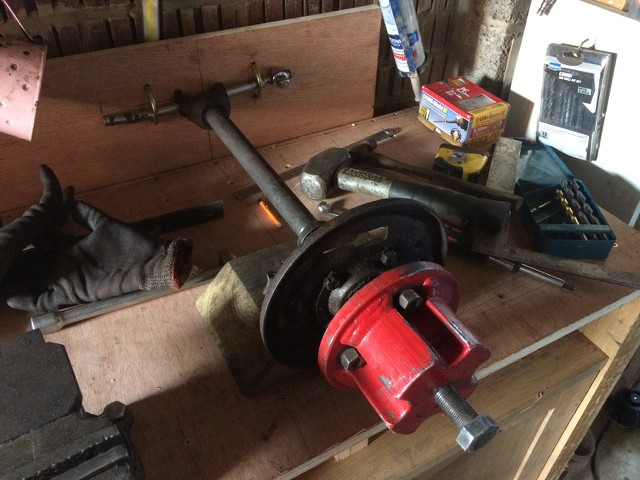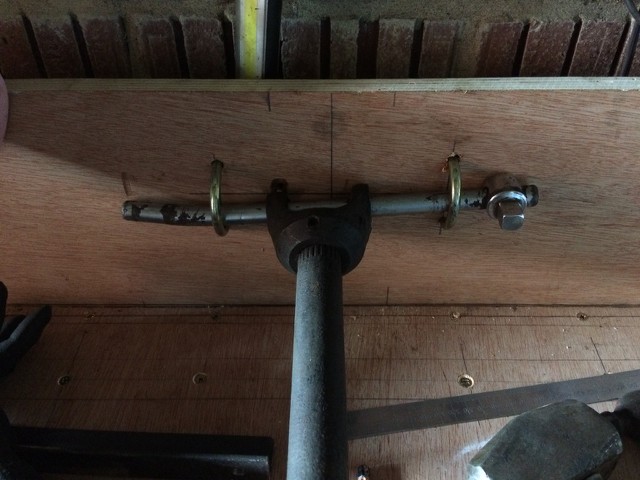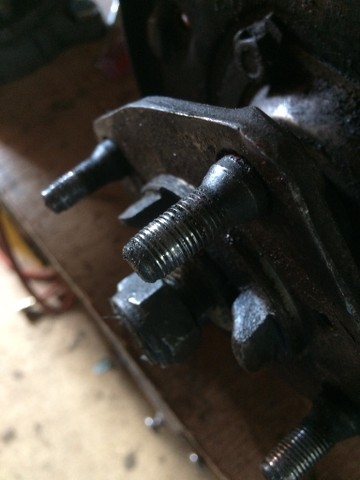
johny
-
Posts
7,652 -
Joined
-
Last visited
-
Days Won
44
Content Type
Profiles
Forums
Blogs
Gallery
Downloads
Store
Events
Posts posted by johny
-
-
brake light? Turn the ignition on, disconnect the wire to the oil pressure switch and touch it down to a clean area of the engine block and check the oil pressure light comes on...
-
well most likely its the bulb which is obviously in the back of the speedo so a bit of manual dexterity is needed to access it. Otherwise the switch is a cylindrical item mounted on the LH side of the engine block with a wire going to it which if disconnected and put to earth should light up the oil light when the ignition is on.
I forgot to ask if you have an oil pressure gauge fitted?
-
uuufff the oil light should come on with the ignition is turned on to prove the bulb and circuit. The pressure switch could be stuck open or the wiring faulty but either way this needs fixing first and to be honest you shouldnt have driven it without it working correctly.....
-
Whats the history of this, did it suddenly start doing it while driving or just on start up and did it get louder and louder? Have you done any jobs in the engine area recently, how many miles do you think its done and I take it the oil pressure warning light works but stays off when running?
-
Theres been a few complaints recently of replacement pumps giving too much pressure so overcoming the needle valve and flooding the float chamber. If the pump manufacturer has used a spring thats too powerful it will give a higher pressure and I believe the original Triumph spec was pretty low. Of course, as Pete says, it could be that the needle valve is past its best and I think thats the first port of call unless youve got a way to check the pump output pressure.....
-
Are we mixing up master and slave bores? Looks like former is 5/8 and later 7/8....
-
Course there's nothing to say couldnt be more than one reason.....
-
I always thought that as its more difficult to suck in air through a hole than blow it out the latter can be smaller and still be sufficient....
-
Great so the final test is with somebody following your car get the engine hot and see if it puffs smoke when coming back on the throttle after letting it trail. If it does then this time maybe youll need to replace guides and valves (how many miles has it done since the last overhaul?)
-
wonder if they marked the piston front so that if they were ever taken out later for new rings and/or bore deglazing its easy to know which way to put them back in. I think once a piston has worn to a position its important it returns there.....
-
yes the flywheel bolts look to close into the centre to catch the springs so I think a spring broke free (motive unknown but could just be metal fatigue as the design at that point doesnt look very good) and was trapped between the flywheel and friction plate where it caused the damage shown. Now I think with the new clutch you have a different problem which seems to be related to the operating mechanism....
-
Perfectly understandable after all the effort.....
-
As I understand it to fit bushes to the older carbs on Vitesses they have to be reamed right through both at the same time once theyre installed to get the correct alignment for the spindle. This would be the same for carbs that have been previously modified to accept bushes.....
-
I think up and down play in the trunnions isnt so worrying as they are always under load (well unless the car is off the ground😲) and I test the ball joints similarly - pull top of wheel for upper wish bone and back/front for track rods....
-
I always think side to side movement in the trunnions is the most important rather than up and down so get the wheel off the ground and pull it in and out at the bottom....
-
9 hours ago, haggis said:
Hi Jonny/ Pete. Definitely no rocker oil feed fitted, and doesn’t appear to be oil from anywhere, I cleaned all the breathers out, the only place is the tiny hole in the filler cap that weeps a little. There are little leaks from both ends of the crank, and there is oil to the rear of the engine, dizzy side from head down.
Next step has got to be cylinder head removal, check valve guides (I hear there are ones with seals somewhere?) and head gasket replacement, sounds like I may have missed the little oil hole that needs sealing on the head gasket.
Thanks
hag
Yes does sound like leaking guides is now the only explanation left. I dont know about using seals though as this would be non standard and of course some lubrication is still necessary so why not go for replacement guides (and valves if required) and also hardened seats at the same time?
-
Hi, I imagine it would be the same as for a 2L which, if checking with the carb on the engine, is 18mm from the lowest part of the float to the bottom face of the carb body while the float is held upwards keeping the needle valve closed.
-
Think thats the standard cap pressure (Spitfire went to 13 later on) and anyway 111ºc should be sufficient shouldnt it? Certainly one possible cause I forgot and which made mine run much hotter was the fuel mixture. I had leaking carb spindles which allowed extra air in to give a very lean mixture so the engine ran hot although this of course was worse at higher loads and not when trundling along.
Our cooling system being 'open' does tend to slowly lose a little by evaporation from the overflow bottle especially at higher coolant temperatures.
-
I suspect a lot of sludge build up is in the block waterways low down so opening the drain valve on the lower RH side to flush through is probably a good idea. However the valve can be seized and/or blocked.....
-
 1
1
-
-
They dont sound bad at all. Ok its not a new engine but no worse than mine and my oil consumption is fine so whats the next step? Possible worn valve guides?
-
Hi Paul, well on boil over the temperature of the water becomes higher than the boiling point of the system as dictated by the pressure rating of the radiator cap. In your case with a 7psi cap the water will have to reach about 111ºc when it starts to turn to steam which, having a greater volume than water, means the rad cap will open to release it (to protect the system from over pressurisation). This steam then leaves the radiator via the overflow pipe to the bottle where it will usually exit to atmosphere producing the usual steam cloud from under the bonnet. This is all good because its protecting your engine from the damage that could occur if you continue to drive.
You obviously havent reached this temperature , although rad caps ratings arent exact, however I think this indicates that your cooling system is close to its limit which on a 50 yr old Vitesse isnt anything unusual and is something Ive been fighting for a while. The problem is that if the engine temperature increases too much, apart from poor running, the lubrication of bearings etc can suffer which could result in major damage. Assuming that your system hadnt lost coolant and as the main external components have been replaced recently the cleanliness of the engine internal waterways is more likely to be the issue. You can try to flush these out in situ but I think cleaning during an engine rebuild is probably the definitve solution. Until then, as Pete asked, the type of fan you have fitted affects cooling, especially when stationary, and there are alternative set ups that could be more effective.....
-
 2
2
-
-
Ive also had some luck with penetrating oil on difficult jobs but it needs a lot of patience with days if not weeks of applying it. Its no good using it and 5 minutes later trying to free off stuff.....
-
Sorry to repeat but is it taking all this effort even with heating of the flange? Cherry red isnt necessary but a good warming with a gas torch before carefully attaching the puller should have made all the difference.....
-
45 minutes ago, Bordfunker said:
I would love to be reporting that the passenger side hub and driveshaft were now two separate entities, however that is still not the case, despite rigging the bench to hold said assembly securely while I assaulted it.
And secured to the back of the bench to prevent unwanted rotation with a couple of Rimmers steering rack clamps which don't fit my rack! I knew I'd find a use for them one day.
With all that set up, I set to with the torque wrench and a makeshift extension, which appeared to be making headway, until I realised that all it was actually doing was easing the wheel nuts off the wheel studs by stripping the threads!
It was at this juncture that I gave up and walked away, hot, sweaty and deeply dispirited.
The hub is now in the hands of my local garage, who have just informed that they can't shift it either, but the mechanic is determined to separate the two components, so it's off to another garage on Monday to be put in a very large press!
Good to know it wasn't just me.
Karl
Blimey and was that using heat on the flange as well?





Engine noise spitfire 1500
in Engine
Posted
Hi Steve, it doesnt really matter how the oil pressure switch is wired up, if its light comes on when the wire is earthed there is a problem with the switch and it must be changed. Once you do this and the light comes on with the ignition you have two possible next steps: investigate whether the oil pump is being driven or just start the engine and see if the oil light goes out.
As youve already driven the car like this I think the second option is probably ok for a short while and, as Pete says, if you can do it with a pressure gauge even better. From there we'll have a think about where to go next....